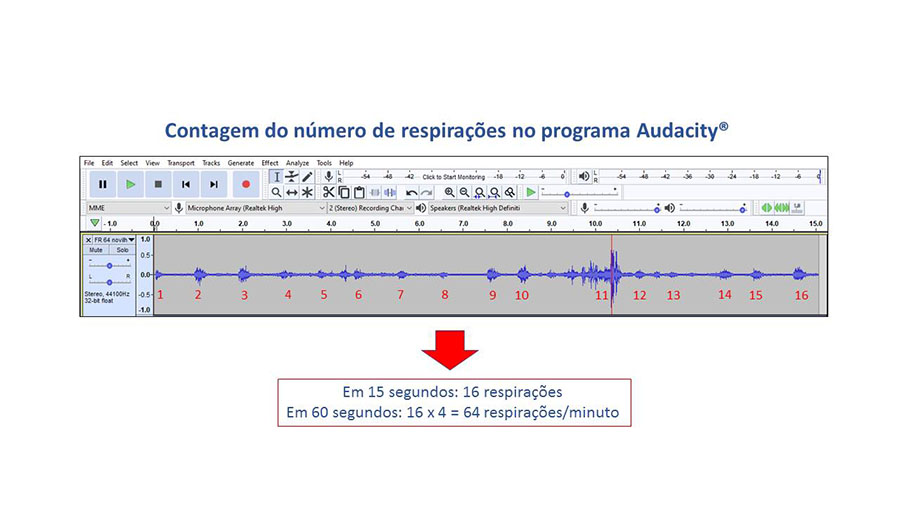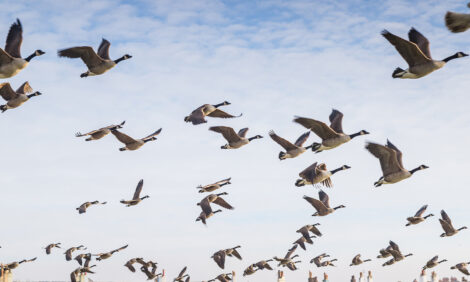



Researchers listen to cows in method validated for the evaluation of thermal comfort
Losses in productivity of animals exposed to high temperatures and humidity are not as quiet as they appear. And it was literally listening to the cows that a survey led by Embrapa Rondônia used bioacoustics, that is, the sounds emitted by the animals, to measure respiratory rate (RF).- Research develops an unprecedented method of bioacoustics to measure the respiratory frequency (RF) of cattle in pasture.
- The technique consists of attaching digital recorders to the animals' halter and evaluating the RF with the help of free software.
- The analysis is accurate, non-invasive and independent of human interference.
- Thermal comfort is essential to increase the productive performance of cattle.
- It can directly assist in the evaluation of animals in the ILPF systems to define areas of shading and management of the herd.
- The novelty of the methodology had international prominence and it was considered one of the ten best works of the Temple Grandin Workshop on Animal Welfare
The team of scientists validated an unprecedented method of evaluating this parameter of thermal comfort, which uses digital recorders attached to the animals' halter, to measure in a practical, precise and non-invasive manner the behavior of grazing cattle.
The work, carried out in partnership with the Federal University of Pelotas ( UFPel ) and the Federal University of Rondônia (Unir ), is supported by free software for analysis. With this, it is possible to obtain acoustic data for a period of up to 48 hours and without human interference. The methodology was validated for the Girolando dairy herd - a cross between the Dutch and Gir breeds - for both heifers and lactating cows.
According to UFPel professor Eduardo Schmitt, this is a methodology that can become a strong ally in assessments of systems such as Crop-Livestock-Forest Integration ( ILPF ), making it possible to identify the level of comfort to which animals are subjected. By listening to the animals' breathing, it is possible to know if they are spending more energy with the heat dissipation mechanisms and, later, correlate this information with the performance. "In a practical view, this measure can assist in research that helps to define, for example, how many square meters of shade should be offered for animals to produce more, how that shade should be arranged in the pasture, among other factors," he says Schmitt.
The professor explains that when cattle are exposed to high temperatures they need to activate mechanisms for heat dissipation, such as increased blood circulation in the skin, increased sweat and respiratory rate. All of this represents an energy cost for the animal, which leads to decreased productivity, increased susceptibility to diseases, which can also result in interferences in fertility. “To assess losses and whether we need to interfere to improve the animals' environmental conditions, the assessment of the respiratory frequency of cows can say a lot,” adds Schmitt.
Method brings innovation to the measurement of animal comfort
Respiratory rate has been used for decades as an indicator of heat stress in animals, a factor that directly influences the production and reproduction of the herd. But the difficulty has always been to keep monitoring throughout the day, since using the traditional (visual) method, this is done by observing the animals by counting the flank movements. The visual evaluation has some limitations, such as difficulty in evaluating at night or in extensive pasture areas with the presence of obstacles (such as trees, for example) for viewing. There is also the possibility of interference from observers during the evaluation period.
Bioacoustics has also been used to characterize the behavior of cattle, as a measure of grazing time, rumination, rest and water intake. But this is the first time that the methodology has been validated to measure respiratory rate. According to Embrapa Rondônia researcher Ana Karina Salman , it is a valuable tool for researchers who study the effect of thermal stress on cattle grazing. “We have successfully validated a new and unprecedented method, in which the respiratory rate is measured from the audios of animals captured by MP3 recorders, very practical and simple to use. The acoustic method can replace the conventional flank movement counting by visual observation ”, says Salman.
The researcher explains that in order to assess the thermal comfort of the animals, it is necessary to simultaneously monitor environmental parameters, such as temperature and relative humidity, and physiological parameters, such as body temperature and respiratory rate. According to her, there are few studies on the physiological responses of cattle to thermal stress and with unreliable results, given the difficulty of continuous visual monitoring throughout the day. Other methods were developed to automatically measure respiratory rate, but they were restricted to animals in stables and with equipment that requires an internet connection, that is, they were not suitable for animals on pasture or in places without internet access.
Another interesting point is that for the Girolando breed, responsible for approximately 80% of the milk produced in Brazil, there is still no scientific definition of the thermoneutrality zone, that is, the ambient temperature range in which the cattle are in thermal comfort. This scenario demonstrates the need for more studies and data so that researchers, technicians and producers, based on more accurate indicators, can carry out decision making on the property, on what measures to adopt and how to minimize thermal stress in the production system, making -the most efficient.
How the new methodology works
To collect audio or acoustic data used to measure respiratory rate, an MP3 recorder, halters, TNT fabric, PVC film and packaging tape are required. The most expensive item on this list is the recorder, which costs, on average, R $ 450.00 for direct purchase, without shipping included. The audio analysis is performed with the aid of the Audacity program , a free (free) software that reproduces the audios captured by the recorders. This program generates oscillograms of audios that are specific to each activity performed by the animals, making it possible to identify the start and end times of each one. Embrapa Rondônia makes available, free of charge, a manual for the collection and analysis of bioacoustic data for the characterization of grazing bovine behavior.
Also check out a video with the process step by step:
The analysis of audio data (identification and counting of breathing sounds) is laborious and requires a trained person. Zootechnician Giovanna de Carvalho, who performed the analysis of respiratory rates (RF) in the research, explains that the same technique described in the bioacoustic manual is used. The difference is that for the FR, it was necessary to go deeper, as it occurs during the entire evaluation, whether the animal is eating or not, which can cause the sounds to overlap.
Thus, only the visual analysis of the sound waves generated by the program is not enough. “The headset is essential for the analysis, as well as a dose of patience and not being afraid to redo the analysis or ask for a second opinion, as there may be doubts about the sounds throughout the process”, recommends Giovanna.
Due to the characteristic pattern of breathing sounds, it should be possible, in the future, to develop an artificial intelligence algorithm that allows to automate this step of the methodology. In addition, this method is not recommended for a herd formed by animals of aggressive temperament, as they can damage the recorders, or for studies that require RF evaluation for more than 48 hours, due to the battery life of the recorders.
The researcher explains that in order to assess the thermal comfort of the animals, it is necessary to simultaneously monitor environmental parameters, such as temperature and relative humidity, and physiological parameters, such as body temperature and respiratory rate.
According to her, there are few studies on the physiological responses of cattle to thermal stress and with unreliable results, given the difficulty of continuous visual monitoring throughout the day. Other methods were developed to automatically measure respiratory rate, but they were restricted to animals in stables and with equipment that requires an internet connection, that is, they were not suitable for animals on pasture or in places without internet access.
Another interesting point is that for the Girolando breed, responsible for approximately 80% of the milk produced in Brazil, there is still no scientific definition of the thermoneutrality zone, that is, the ambient temperature range in which the cattle are in thermal comfort. This scenario demonstrates the need for more studies and data so that researchers, technicians and producers, based on more accurate indicators, can carry out decision making on the property, on what measures to adopt and how to minimize thermal stress in the production system, making -the most efficient.
How the new methodology works
To collect audio or acoustic data used to measure respiratory rate, an MP3 recorder, halters, TNT fabric, PVC film and packaging tape are required. The most expensive item on this list is the recorder, which costs, on average, R $ 450.00 for direct purchase, without shipping included. The audio analysis is performed with the aid of the Audacity program , a free (free) software that reproduces the audios captured by the recorders. This program generates oscillograms of audios that are specific to each activity performed by the animals, making it possible to identify the start and end times of each one. Embrapa Rondônia makes available, free of charge, a manual for the collection and analysis of bioacoustic data for the characterization of grazing bovine behavior.
Also check out a video with the process step by step:
The analysis of audio data (identification and counting of breathing sounds) is laborious and requires a trained person. Zootechnician Giovanna de Carvalho, who performed the analysis of respiratory rates (RF) in the research, explains that the same technique described in the bioacoustic manual is used. The difference is that for the FR, it was necessary to go deeper, as it occurs during the entire evaluation, whether the animal is eating or not, which can cause the sounds to overlap.
Thus, only the visual analysis of the sound waves generated by the program is not enough.
“The headset is essential for the analysis, as well as a dose of patience and not being afraid to redo the analysis or ask for a second opinion, as there may be doubts about the sounds throughout the process”, recommends Giovanna.
Due to the characteristic pattern of breathing sounds, it should be possible, in the future, to develop an artificial intelligence algorithm that allows to automate this step of the methodology. In addition, this method is not recommended for a herd formed by animals of aggressive temperament, as they can damage the recorders, or for studies that require RF evaluation for more than 48 hours, due to the battery life of the recorders.
For more information, click here.



